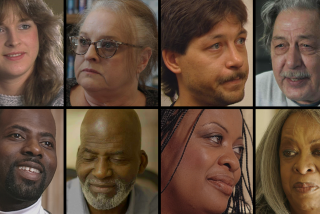Building a Family in Steps : A ‘blended’ household isn’t anyone’s ideal, but stepfamilies are growing in number. Here’s what one such family (and two experts) advise about coping.
- Share via
Fifteen years ago, when therapists Emily and John Visher founded the Stepfamily Assn. of America, they were struck by how little some people knew about stepfamilies. One colleague called their interest a gimmick. An attorney argued that John could not be a stepfather unless the biological father had died. A teacher, noticing their son had a different last name, called them in for a conference suggesting he was not receiving enough love.
Today the number of remarried couples and their relatives has soared to the point where they may soon become the majority family type. There are simple stepfamilies (one spouse with biological children) or complex (both have children). There are multiple new, vaguely defined terms, such as “blended,” “reconstituted” or “acquired,” to describe the various configurations. There are stepsiblings, stepgrandparents and parent substitutes who must be taken into account at holidays, marriages and funerals.
But the Vishers, poised to receive the award for Distinguished Professional Contribution to Marriage and Family Therapy on Friday at the Anaheim gathering of the American Assn. for Marriage and Family Therapy, say they are still fighting misunderstandings and stigmas over stepfamilies.
Laws and public institutions such as schools do not always accord stepparents the same rights as biological parents. (Stepparents cannot, for instance, legally authorize medical treatment.) Stepfamilies ranked last in a survey of college students asking their preferred family form. Research continues to show that children of divorce and remarriage have twice as many problems as those from intact families.
“We really do feel they don’t have a warm fuzzy place in our society,” said Emily Visher, a clinical psychologist. “As a result that contributes to difficulties people have forming successful stepfamilies.”
Moreover, said John, a psychiatrist, the continuing stigmas “threaten to leave what will soon become the majority family type without a recognizable seal of approval.”
The Vishers, of Lafayette, became personally involved in the stepfamily movement when they formed a stepfamily 34 years ago. Their new family integrated five of their combined eight children, ages 5 to 15. (The other three remained with their mother, John’s ex-wife.)
As they tried to build a new family, they wrote several books for parents and therapists, including “How to Win as a Step-Family and “Old Loyalties, New Ties.” Their Lincoln, Neb.-based national support group has 65 chapters.
The Vishers rode the divorce tidal wave that by 1975 was helping to create a half-million new stepfamilies a year. Back then, many professionals, boosted by the human potential and women’s movements, did not discourage unhappy couples--even those with children--from divorcing, reasoning that if the parents were happy, the children would be too. Now, the pendulum is swinging back as divorce rates drop and evidence grows that what is best for parents might not be best for children.
Despite a current backlash against divorce, the Vishers’ message continues to sound upbeat, if somewhat defensive. Said John, “We think one of the positives is that children do have more contact with more parenting adults and more role models.”
But the new stepfamily critics, now armed with research the Vishers helped initiate, are coming from the political center as well as the right to argue that remarriage can be not only painful but extremely harmful to children, both mentally and physically. In an April Atlantic Monthly article, “Dan Quayle Was Right,” social scientist Barbara Dafoe Whitehead concluded that “children living with stepparents appear to be even more disadvantaged than children living in a stable single-parent family.”
Whitehead cited studies showing that girls often see stepfathers as intruders and have a harder time adjusting than boys. In one Canadian study, preschool children were 40% more likely than children from intact families to suffer physical or sexual abuse from stepfathers. Stepparents also were found to spend less time and money on the children and have lower expectations for them.
“Whatever its causes, the diminished investment in children in both single-parent and stepparent families has a significant impact on their life chances,” Whitehead wrote.
Such critics are reacting to what they perceive as denial of the problems, said researcher Andrew Cherlin, a sociologist at Johns Hopkins University in Baltimore. “We ought to be troubled by the effects of divorce on children. The difficulty here is to strike a balance between the harm a minority of children face and the recognition that most children will not suffer long-term serious harm.”
Studies show that children in remarried families fare about the same as those from divorced families, with both experiencing twice as many problems as children in intact families.
“If remarriage occurs in early adolescence, kids respond very negatively,” said divorce researcher Mavis Hetherington, professor of psychology at the University of Virginia. Yet, she said, the Vishers’ optimism is not misplaced. “There are more problems, but most can adjust.”
Indeed, 75% of children in remarried families show no long-term problems, Hetherington said. Despite common assertions that second marriages are more likely to end in divorce, there is no clear-cut evidence to that effect, the U.S. Census Bureau says.
The Vishers said they made many mistakes themselves. “Emily and I started out with wildly unrealistic expectations,” John said.
For instance, they mistakenly thought that working in the mental-health field would bring them success, that everything would smooth out after a brief transition period, and that their children would automatically share their own happiness.
“We did not see it from the children’s point of view,” Emily said.
“Their lives had been torn apart and they were feeling loss, lack of control and many loyalty conflicts,” John said.
The Vishers recalled that at first they tried to communicate with John’s ex-wife through the children. “When divorce first came up, the wisdom in the country was, ‘Don’t have any more contact. Get on with your life. Forget the other person,’ ” Emily said.
“Nowadays people realize that stepfamilies keep on going, they come to graduations, marriages, funerals.”
Now, they said, they believe that adults need to form a “parent coalition” to communicate with one another for the sake of future generations.
They said they also mistakenly pushed family togetherness over individual relationships with each child when they were a new family. Now they believe it is more important for parents to form new one-on-one relationships with all the children in the family. “We’re doing it now, with our adult children,” Emily said.
One reason they created the Stepfamily Assn. of America was to provide what they wish they had had in the beginning: knowledge and support.
In addition they have influenced many other therapists to view and treat stepfamilies differently from intact families.
For example, Emily said, one therapist advised a troubled stepmother to try to act as if she were the biological mother.
“From our perspective that’s diametrically opposite to what would have been helpful. He’s trying to make them into a nuclear, first-marriage family, which they are not. What she was doing was doing that too much. What she needed to do was back off. The father was the one that should take responsibility. He was tired of it and was giving it to her.”
Remarriage is particularly dangerous territory for people who are sensitive to rejection, the Vishers say. “Initially for stepparents, there’s a lot of rejection and a lot of feelings of not belonging. It hits you in your psychologically sensitive spots,” Emily said.
From the beginning, the stepfamily structure conflicts with basic human needs--to be accepted, cared about and loved; to have secure attachments to special individuals; to belong to a group and not be a stranger; to have personal autonomy and control. “No way in the beginning those needs are going to be met. That’s why it hurts so much,” John said.
Current research with stepparents is showing that their adjustment improved when they believed their experiences were normal and not a result of faulty personalities. They also did better when they knew what to expect.
Said John: “We often say one of the important things is, you don’t have to love your stepchildren. It’s enough at first to just tolerate or accept them. So many people think, ‘Since he’s the son of my husband, I should love him like a biological child.’ We say therapists should give permission to clients not to love their stepchildren, or to let it come gradually.”
Hetherington said her own research has shown that most stepparents “never feel as warm toward their stepchildren as toward their biological children. They tend not to try to control and discipline them, so they are more detached and children perceive their stepparents more negatively.”
Nevertheless, the Vishers say they have continued to have good relations with their children “as consultants” even after they left home.
The couple bragged gently about their own children, all eight of whom plan to attend their award ceremony this week. “We’re proud of them all,” Emily said. “They are great people. They have great families.”
Said John: “The thing we’re proudest of is, they’re happy and they’re good parents themselves.”
Added Emily: “It’s what we always wanted.”
Stepfamily Myths According to John and Emily Visher, society still holds unhelpful myths about stepfamilies that can prevent them from being successful:
* Stepfamilies are the same as biological families.
* Stepfamily adjustment will be attained quickly.
* Love and caring will develop instantaneously.
* Withdrawing a child from a biological parent enhances the relationship with the stepparent of the same sex.
* Working hard prevents the development of a “wicked stepmother” image.
* Anything negative that happens is a result of being in a stepfamily.
Source: “Old Loyalties, New Ties,” John and Emily Visher
Stepfamily Lessons Members of stepfamilies must consciously learn to bond with people who are different from themselves. In some ways, their tasks can be instructive to those in any family, since they must:
* Deal productively with losses and changes.
* Accept and appreciate differences.
* Enhance relationships by increasing one-on-one interactions.
* Develop a solid couple bond.
* Negotiate different developmental needs.
* Establish new traditions.
* Create a parenting coalition with other step- and biological parents.
* Risk involvement in school and other activities despite little societal support.
Source: “Old Loyalties, New Ties,” John and Emily Visher
Remarried With Stepchildren
* Since 1965, American couples have been divorcing and remarrying in unprecedented numbers, profoundly altering family structures and childhood experiences.
* Between the late 1960s and 1980 the divorce rate doubled, peaking between 1975 and 1980, when more than half of all marriages were expected to end in divorce.
* The divorce rate is now slowing. If the trend continues, about four out of 10 marriages for women age 20-24 in 1990 will end in divorce and two-thirds of divorced women will remarry, resulting in a continued increase in the number of reconstituted, blended and/or stepfamilies.
* Counting step and biological parents, grandparents, siblings and children, at least one-third of the U.S. population was part of stepfamilies in 1987. There are 5.3 million married couples with stepchildren at home.
* The proportion of the population in stepfamilies will grow as the older generation, which experienced more stable marriages, dies off. By the year 2000 half the population may be part of stepfamilies.
Sources: U.S. Bureau of the Census, Paul Glick, retired senior demographer with the bureau and adjunct professor in the Department of Sociology at Arizona State University


